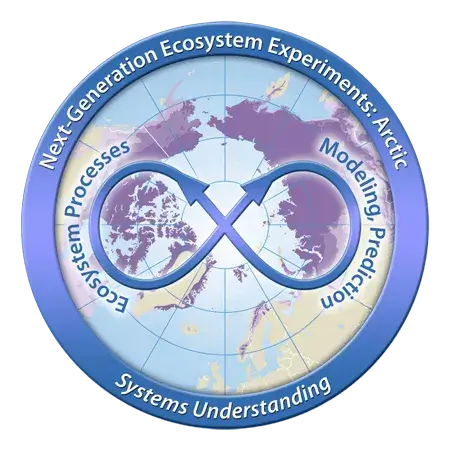Fer, Istem, et al. “Beyond Ecosystem Modeling: A Roadmap to Community Cyberinfrastructure for Ecological data‐model Integration”. Global Change Biology, vol. 27, no. 1, 2021, pp. 13-26, https://doi.org/10.1111/gcb.15409.
Publications
Displaying 61 - 80 of 84
By year of publication, then alphabetical by title
- Mekonnen, Zelalem A., et al. “Changes in Precipitation and Air Temperature Contribute Comparably to Permafrost Degradation in a Warmer Climate”. Environmental Research Letters, vol. 16, no. 2, 2021, p. 024008, https://doi.org/10.1088/1748-9326/abc444.
- Tang, Jinyun Y., et al. “Conceptualizing Biogeochemical Reactions With an Ohm’s Law Analogy”. Journal of Advances in Modeling Earth Systems, vol. 13, no. 10, 2021, https://doi.org/10.1029/2021MS002469.
- Schneider von Deimling, Thomas, et al. “Consequences of Permafrost Degradation for Arctic Infrastructure – Bridging the Model Gap Between Regional and Engineering Scales”. The Cryosphere, vol. 15, no. 5, 2021, pp. 2451-7, https://doi.org/10.5194/tc-15-2451-2021.
- Hollingsworth, Teresa N., et al. “Does Fire Always Accelerate Shrub Expansion in Arctic Tundra? Examining a Novel Grass-Dominated Successional Trajectory on the Seward Peninsula”. Arctic, Antarctic, and Alpine Research, vol. 53, no. 1, 2021, pp. 93-109, https://doi.org/10.1080/15230430.2021.1899562.
- Chen, Yang, et al. “Future Increases in Arctic Lightning and Fire Risk for Permafrost Carbon”. Nature Climate Change, vol. 11, no. 5, 2021, pp. 404-10, https://doi.org/10.1038/s41558-021-01011-y.
- Uhlemann, Sebastian, et al. “Geophysical Monitoring Shows That Spatial Heterogeneity in Thermohydrological Dynamics Reshapes a Transitional Permafrost System”. Geophysical Research Letters, vol. 48, no. 6, 2021, https://doi.org/10.1029/2020GL091149.
- Wainwright, Haruko M., et al. “High-Resolution Spatio-Temporal Estimation of Net Ecosystem Exchange in Ice-Wedge Polygon Tundra Using In Situ Sensors and Remote Sensing Data”. Land, vol. 10, no. 7, 2021, p. 722, https://doi.org/10.3390/land10070722.
- Dengel, Sigrid, et al. “Influence of Tundra Polygon Type and Climate Variability on Carbon Dioxide and Methane Fluxes Near Utqiagvik, Alaska”. Journal of Geophysical Research: Biogeosciences, vol. 126, no. 12, 2021, https://doi.org/10.1029/2021JG006262.
- Sulman, Benjamin N., et al. “Integrating Arctic Plant Functional Types in a Land Surface Model Using Above‐ and Belowground Field Observations”. Journal of Advances in Modeling Earth Systems, vol. 13, no. 4, 2021, https://doi.org/10.1029/2020MS002396.
- Yang, Dedi, et al. “Landscape-Scale Characterization of Arctic Tundra Vegetation Composition, Structure, and Function With a Multi-Sensor Unoccupied Aerial System”. Environmental Research Letters, vol. 16, no. 8, 2021, p. 085005, https://doi.org/10.1088/1748-9326/ac1291.
- Cawse-Nicholson, Kerry, et al. “NASA’s Surface Biology and Geology Designated Observable: A Perspective on Surface Imaging Algorithms”. Remote Sensing of Environment, vol. 257, 2021, p. 112349, https://doi.org/10.1016/j.rse.2021.112349.
- Harp, Dylan R., et al. “New Insights into the Drainage of Inundated Ice-Wedge Polygons Using Fundamental Hydrologic Principles”. The Cryosphere, vol. 15, no. 8, 2021, pp. 4005-29, https://doi.org/10.5194/tc-15-4005-2021.
- Riley, William J., et al. “Non-Growing Season Plant Nutrient Uptake Controls Arctic Tundra Vegetation Composition under Future Climate”. Environmental Research Letters, vol. 16, no. 7, 2021, p. 074047, https://doi.org/10.1088/1748-9326/ac0e63.
- Sjöberg, Ylva, et al. “Permafrost Promotes Shallow Groundwater Flow and Warmer Headwater Streams”. Water Resources Research, vol. 57, no. 2, 2021, https://doi.org/10.1029/2020WR027463.
- Yuan, Fengming, and Shuhua Yi. “Responses of Boreal Forest Ecosystems and Permafrost to Climate Change and Disturbances: A Modeling Perspective”. Arctic Hydrology, Permafrost and Ecosystems, Springer International Publishing, 2021, pp. 849-92, https://doi.org/10.1007/978-3-030-50930-9_29.
- Kropp, Heather, et al. “Shallow Soils Are Warmer under Trees and Tall Shrubs across Arctic and Boreal Ecosystems”. Environmental Research Letters, vol. 16, no. 1, 2021, p. 015001, https://doi.org/10.1088/1748-9326/abc994.
- Watts, Jennifer D., et al. “Soil Respiration Strongly Offsets Carbon Uptake in Alaska and Northwest Canada”. Environmental Research Letters, vol. 16, no. 8, 2021, p. 084051, https://doi.org/10.1088/1748-9326/ac1222.
- Virkkala, Anna-Maria, et al. “Statistical Upscaling of Ecosystem Carbon Dioxide Fluxes across the Terrestrial Tundra and Boreal Domain: Regional Patterns and Uncertainties”. Global Change Biology, vol. 27, no. 17, 2021, pp. 4040-59, https://doi.org/10.1111/gcb.v27.1710.1111/gcb.15659.
- Roy_Chowdhury, Taniya, et al. “Temporal, Spatial, and Temperature Controls on Organic Carbon Mineralization and Methanogenesis in Arctic High-Centered Polygon SoilsData_Sheet_1.Docx”. Frontiers in Microbiology, vol. 11, 2021, https://doi.org/10.3389/fmicb.2020.61651810.3389/fmicb.2020.616518.s001.

